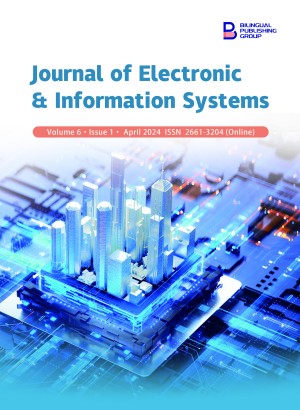Sliding Mode-Based Distributed Trajectory Tracking Control of Four-body Train Systems
DOI:
https://doi.org/10.30564/jeis.v6i1.6077Abstract
This paper considers the speed tracking of a four-body train system modelled mathematically based on Newton’s second law, which is described by a large-scale interconnected system with four subsystems. Uncertainties are included in the systems to represent the potential impacts on system performance caused by mechanical wear and external environmental changes. An adaptive sliding mode technique is employed to design a distributed control scheme to guarantee tracking accuracy. Coordinate transformations are introduced to transfer the model of train systems to a system in regular form to facilitate the design of the hyperplane and controllers. The Barbashin-Krasovskii theorem is employed to show the reachability of the hyperplane. In simulations, the Gaussian function is chosen as the desired signal, representing time-varying characteristics relevant to real-world situations, and the result demonstrates the feasibility of the proposed control strategy.
Keywords:
Adaptive control; Distributed control; Large-scale interconnected systems; Sliding mode control; Trajectory trackingReferences
[1] Zhao, L., Cai, B., Xu, J., et al., 2013. Study of the track-train continuous information transmission process in a high-speed railway. IEEE Transactions on Intelligent Transportation Systems. 15(1), 112–121. DOI: https://doi.org/10.1109/TITS.2013.2274617
[2] Lin, P., Huang, Y., Zhang, Q., et al., 2020. Distributed velocity and input constrained tracking control of high-speed train systems. IEEE Transactions on Systems, Man, and Cybernetics: Systems. 51(12), 7882–7888. DOI: https://doi.org/10.1109/TSMC.2020.2987339
[3] He, Y., Wu, J., Zheng, Y., et al., 2022. Track defect detection for high-speed maglev trains via deep learning. IEEE Transactions on Instrumentation and Measurement. 71, 1–8. DOI: https://doi.org/10.1109/TIM.2022.3151165
[4] Yan, X.G., Wang, J.J., Lu, X.Y., et al., 1998. Decentralized output feedback robust stabilization for a class of nonlinear interconnected systems with similarity. IEEE Transactions on Automatic Control. 43(2), 294–299. DOI: https://doi.org/10.1109/9.661085
[5] Yan, X.G., Xie, L., 2003. Reduced-order control for a class of nonlinear similar interconnected systems with mismatched uncertainty. Automatica. 39(1), 91–99. DOI: https://doi.org/10.1016/S0005-1098(02)00194-2
[6] Tan, L.N., 2018. Distributed H∞ optimal tracking control for strict-feedback nonlinear large-scale systems with disturbances and saturating actuators. IEEE Transactions on Systems, Man, and Cybernetics: Systems. 50(11), 4719–4731. DOI: https://doi.org/10.1109/TSMC.2018.2861470
[7] Zhang, D., Nguang, S.K., Yu, L., 2017. Distributed control of large-scale networked control systems with communication constraints and topology switching. IEEE Transactions on Systems, Man, and Cybernetics: Systems. 47(7), 1746–1757. DOI: https://doi.org/10.1109/TSMC.2017.2681702
[8] Cai, H., Hu, G., 2017. Distributed tracking control of an interconnected leader—follower multiagent system. IEEE Transactions on Automatic Control. 62(7), 3494–3501. DOI: https://doi.org/10.1109/TAC.2017.2660298
[9] Liu, C., Zhang, H., Xiao, G., et al., 2019. Integral reinforcement learning based decentralized optimal tracking control of unknown nonlinear large-scale interconnected systems with constrained-input. Neurocomputing. 323, 1–11. DOI: https://doi.org/10.1016/j.neucom.2018.09.011
[10] Ren, X.X., Yang, G.H., Li, X.J., 2019. Global adaptive fuzzy distributed tracking control for interconnected nonlinear systems with communication constraints. IEEE Transactions on Fuzzy Systems. 28(2), 333–345. DOI: https://doi.org/10.1109/TFUZZ.2019.2905827
[11] Pagilla, P.R., Dwivedula, R.V., Siraskar, N.B., 2007. A decentralized model reference adaptive controller for large-scale systems. IEEE/ASME Transactions on Mechatronics. 12(2), 154–163. DOI: https://doi.org/10.1109/TMECH.2007.892823
[12] Yan, X.G., Spurgeon, S.K., Edwards, C., 2018. Variable structure control of complex systems analysis and design. Springer: Berlin.
[13] Zhu, G., Nie, L., Lv, Z., et al., 2020. Adaptive fuzzy dynamic surface sliding mode control of large-scale power systems with prescribe output tracking performance. ISA Transactions. 99, 305–321. DOI: https://doi.org/10.1016/j.isatra.2019.08.063
[14] Ding, Y.H, Yan, X.G., Mao, Z.H., et al. (editors), 2022. Sliding mode based decentralized tracking control of underactuated four-body systems. 2022 13th Asian Control Conference (ASCC); 2022 May 4–7; Jeju, Korea. New York: IEEE. p. 1765–1770. DOI: https://doi.org/10.23919/ASCC56756.2022.9828154
[15] Song, Q., Song, Y.D., Tang, T., et al., 2011. Computationally inexpensive tracking control of high-speed trains with traction/braking saturation. IEEE Transactions on Intelligent Transportation Systems. 12(4), 1116–1125. DOI: https://doi.org/10.1109/TITS.2011.2143409
[16] Wang, X., Zhu, L., Wang, H., et al., 2019. Robust distributed cruise control of multiple high-speed trains based on disturbance observer. IEEE Transactions on Intelligent Transportation Systems. 22(1), 267–279. DOI: https://doi.org/10.1109/TITS.2019.2956162
[17] Mao, Z., Tao, G., Jiang, B., et al., 2021. Zero dynamics analysis and adaptive tracking control of underactuated multibody systems with flexible links. International Journal of Control. 94(7), 1931–1943. DOI: https://doi.org/10.1080/00207179.2019.1686179
[18] Mao, Z., Tao, G., Jiang, B., et al., 2020. Adaptive control design and evaluation for multibody high-speed train dynamic models. IEEE Transactions on Control Systems Technology. 29(3), 1061–1074. DOI: https://doi.org/10.1109/TCST.2020.2991119
[19] Tang, H., Wang, Q., Feng, X., 2017. Robust stochastic control for high-speed trains with nonlinearity, parametric uncertainty, and multiple time-varying delays. IEEE Transactions on Intelligent Transportation Systems. 19(4), 1027–1037. DOI: https://doi.org/10.1109/TITS.2017.2710138
[20] Rochard, B.P., Schmid, F., 2000. A review of methods to measure and calculate train resistances. Proceedings of the Institution of Mechanical Engineers, Part F: Journal of Rail and Rapid Transit. 214(4), 185–199. DOI: https://doi.org/10.1243/0954409001531306
[21] Hassan, K.K., 2001. Nonlinear systems. Prentice Hall: Hoboken.
[22] Cui, S., Datcu, M., 2012. Statistical wavelet subband modeling for multi-temporal SAR change detection. IEEE Journal of Selected Topics in Applied Earth Observations and Remote Sensing. 5(4), 1095–1109. DOI: https://doi.org/10.1109/JSTARS.2012.2200655
[23] Mallat, S.G., 1989. A theory for multiresolution signal decomposition: The wavelet representation. IEEE Transactions on Pattern Analysis and Machine Intelligence. 11(7), 674–693. DOI: https://doi.org/10.1109/34.192463
Downloads
How to Cite
Issue
Article Type
License
Copyright © 2024 Yueheng Ding, Xinggang Yan

This is an open access article under the Creative Commons Attribution-NonCommercial 4.0 International (CC BY-NC 4.0) License.




 Yueheng Ding
Yueheng Ding






